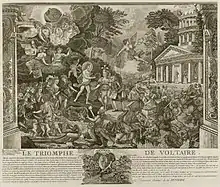The Apotheosis of Voltaire
The Apotheosis of Voltaire led by Truth and crowned by Glory (French: “l’Apothéose de Voltaire conduit par la Vérité et couronné par la Gloire”), also known as “The Triumph of Voltaire” (French: Le Triomphe de Voltaire) is a 1775 oil painting by Alexandre Duplessis.[1][2][3][4][5][6]

In the centre of the painting, Melpomene muse of tragedy, leads Voltaire towards Apollo while behind the god a putto holds up a waiting crown of immortality. Behind Voltaire, various critics and enemies are driven into hell while Thalia, muse of comedy, laughs in amusement. In the background other putti hang a wreath over a bust of Voltaire.[2] Above Voltaire the chariot of Apollo, empty, approaches from across the sky. On the right stands the Temple of Memory with its central niche vacant, flanked by Sophocles and Euripides on one side with Corneille and Racine on the other. Many other details in the painting are described in twenty-three lines of commentary at the bottom of the print edition.[7]
The artist, Alexandre Duplessis, an amateur who worked mainly in Lyon, approached Voltaire for permission to paint him. Although in his correspondence Voltaire compared him to Rubens,[8] Madame de Genlis described the painting as a pub sign (“enseigne à bière”).[7]
Voltaire owned the original painting, which is still in the collection at Ferney. Duplessis created several engravings of the painting, probably when Voltaire's remains were transferred to the Panthéon in 1791, or soon after.[2][4]
There is also a different painting currently in the collection of the Musée Carnavalet by Robert-Guillaume Dardel which is known both as “Allegory to the glory of Voltaire” (French: Allégorie à la gloire de Voltaire) and as “The Apotheosis of Voltaire”.[9][6] Another painting, based on Dardel’s work is currently in the National Gallery of Art.[10][11]
References
- Giraud, Sylvie (29 April 2015). "Le Triomphe de Voltaire". eman-archives-org. e-Man. Retrieved 29 August 2021.
- "Le Triomphe de Voltaire". artic.edu. Art Institute of Chicago. Retrieved 29 August 2021.
- Moureau, François (2006). La plume et le plomb: espaces de l'imprimé et du manuscrit au siècle des Lumières. Paris: PUPS. p. 157. ISBN 9782840504665. Retrieved 29 August 2021.
- "Le triomphe de Voltaire". britishmuseum.org. British Museum. Retrieved 29 August 2021.
- "The Philosopher's Private Sphere" (PDF). chateau-ferney-fr. Château de Voltaire. Retrieved 30 August 2021.
- Duplessis, George (1881). Inventaire de la collection d'estampes relatives à l'histoire de France, léguée en 1863 à la Bibliothèque nationale par M. Michel Hennin. Paris: H. Menu. pp. 310–311. Retrieved 13 September 2021.
- "Le Triomphe de Voltaire". bnf.fr. Bibliothèque Nationale de France. Retrieved 29 August 2021.
- Kohle, Hubertus; Reichardt, Rolf (2007). Visualizing the Revolution: Politics and Pictorial Arts in Late Eighteenth-century France. London: Reaktion Books. p. 219. ISBN 978-1861893123.
- "Allegory of the glory of Voltaire". parismuseescollections.paris.fr. Paris Musées. Retrieved 13 September 2021.
- "Apothéose de Voltaire (The Apotheosis of Voltaire), 1782". nga.gov. National Gallery of Art. Retrieved 13 September 2021.
- D’Argental, Raoul (1878). Histoire complète de la vie de Voltaire: pages extraites des oevres de ses principaux biographes, des mémoires du XVIIIe siècle et de divers autre ouvrages. Paris: Sandoz et Fischbacher. p. 428. Retrieved 13 September 2021.